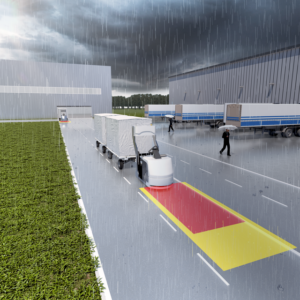Advancements in safety laser scanners make it possible to reliably operate in harsh outdoor settings
Many warehouses and DCs operate as controlled environments, where most of the activity that takes place happens within their four walls. Climate-controlled, well lit, and clean, these environments provide the perfect backdrop for the implementation of sensor-enabled mobile platforms.
But what happens when a company needs that equipment to work outdoors under harsh conditions? Or when it’s operating in an area filled with dust and dirt particles that both fill the air and accumulate on the equipment’s screen? Or when it has to move products around in a freezer environment that can drop as low as -20 degrees?
These tough conditions require technology tools that can do their jobs in a harsh environment. As the first safety laser scanner rated for outdoor use, SICK, Inc.’s outdoorScan3 operates in a wide range of mobile and stationary outdoor applications. Using intelligent algorithms and outdoor safeHDDM® scanning technology, the sensors are built with a durable housing, smart connectivity, and advanced diagnostic functions.
Tyler Glieden, market product manager at SICK, Inc., says outdoorScan3 is one of the most advanced scanning technologies for safety laser scanners available on the market today.
“Because they filter out particles like dust and dirt, the scanners can discern between those particles and people/objects,” Glieden said.
Advanced options for outdoor sensor technology
Before outdoorScan3 became available in 2019, companies had few options for outdoor sensor technology: either use a safety laser scanner rated for indoor use, or one that wasn’t as flexible and customizable as a safety laser scanner.
“The outdoorScan3 enables vehicles that either are extending processes from indoors to outdoors, or that are linking processes between buildings,” Glieden said.
The latter is extremely useful for the high number of companies that want to extend their automation across different buildings at the same facility, and are adding more mobile platforms as part of that trend.
The sensor technology can assess and interact with eight different “view zones” at the same time and instruct the vehicle based on zone infringements, obstacles, and other potential issues. The scanner can also change the area or the zone that it’s looking at based on the vehicle’s speed, direction of travel, wheel positioning, or load information.
Finally, the sensors provide data from the scanner over an ethernet connection, which helps enable a rich, data-driven guidance. Combined, these capabilities enable a more efficient and productive system that wasn’t available in the past, when technology was limited.
“Advancements in safety laser scanner technology have allowed mobile platforms to become much more productive, and not just within indoor settings anymore,” Glieden said.
Want to learn more about applications in for safety laser scanners in cold settings?






